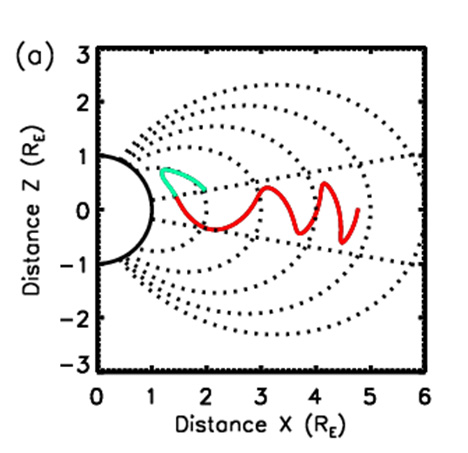HOTRAY Ray Tracing Model
HOTRAY Ray Tracing Model
HOTRAY is a ray tracing computer code designed to trace the path of electromagnetic waves in a hot magnetised plasma. HOTRAY has been used to understand the generation and propagation of plasma waves at the Earth, Jupiter, Saturn and laboratory plasmas.
Features
The HOTRAY code calculates the ray path and the growth and decay of the wave due to plasma instabilities. The code includes several important features:
- Propagation of waves in a hot or cold magnetised plasma
- Propagation in three dimensions
- Propagation of electromagnetic or electrostatic waves
- Propagation in a multi-ion plasma
- Wave growth and decay due to unstable electron and ion distributions
- Wave polarisation
Method
The code integrates Hamilton’s equations to find the ray path and the k-vector subject to solving the hot (cold) plasma dispersion relation. The code requires as input:
- Wave frequency and start location
- Magnetic field model
- Plasma density model
- Electron and ion distribution functions
The output is the ray path and wave properties such as the path integrated wave gain and the wave polarisation.
Restrictions
HOTRAY is restricted to
- WKB approximation (that variations in the plasma over a wavelength are small)
- Linear instabilities
- Non-relativistic effects
References
HOTRAY was written by Richard B Horne at the British Antarctic Survey. The first research paper was published in 1988 [Horne, 1988], but the key reference is Horne [1989]:
http://onlinelibrary.wiley.com/doi/10.1029/JA094iA07p08895/abstract
The code was substantially updated to include heavy ions and the key reference is Horne and Thorne [1993]
http://onlinelibrary.wiley.com/doi/10.1029/92JA02972/abstract
The code is so general it is still used today – one of the latest references is Horne [2015]:
http://onlinelibrary.wiley.com/doi/10.1002/2014GL062406/full
Availability and Contact
HOTRAY is not freely available. It may be available for joint research projects via collaboration. For more information contact Richard Horne (rh@bas.ac.uk).

Richard Horne
Science Leader - IMP 1
BAS Science Strategy Executive Group, Space Weather and Atmosphere team, BAS Executive team